ABS MERCEDES-BENZ S-CLASS CABRIOLET 2018 Owner's Manual
[x] Cancel search | Manufacturer: MERCEDES-BENZ, Model Year: 2018, Model line: S-CLASS CABRIOLET, Model: MERCEDES-BENZ S-CLASS CABRIOLET 2018Pages: 502, PDF Size: 6.27 MB
Page 13 of 502

1Speedom eter ŌåÆ
208
2 AIR BODY CONTROL malfunctioning ŌåÆ
454
3 #! Turn signal light ŌåÆ
109
4 Multifunction display ŌåÆ
211
5 Tach ome ter ŌåÆ
208
6 ├ź ESP
┬«OFF ŌåÆ
447
├Ę ESP
┬«ŌåÆ
447
7 K High beam ŌåÆ
109
L Low beam ŌåÆ
108
T Parking lights ŌåÆ
108
8 ? Coolant too hot/cold ŌåÆ
456
9 Coolant temp erature gauge ŌåÆ
208
A ┬Ę Distance warning ŌåÆ
454
B ├É Steering assis tance malfunction ŌåÆ
455
C # Electrical malfunction ŌåÆ
456
D Brakes (red) ŌåÆ
447
$ USA only
J Canada only
E ├╝ Seat belt is not fastened ŌåÆ
454
F Fuel le vel display
G 8 Fuelreser vewith fuel filler flap location
indicator ŌåÆ
456,
456
H R Rear fog light ŌåÆ
109
I 6 Restra int sy stem ŌåÆ
34
J % Indicator lamp has no function
K ; Check Engine ŌåÆ
456
L Elect ric park ing brake applied (red) ŌåÆ
447
F USA only
! Canada only
M h Tire pressure monitoring sy stem ŌåÆ
460
N ! ABS malfunction ŌåÆ
447
O ! Electric pa rking brake (yellow) ŌåÆ
447
At aglance ŌĆō Warning and indicator lamps 11
Page 27 of 502
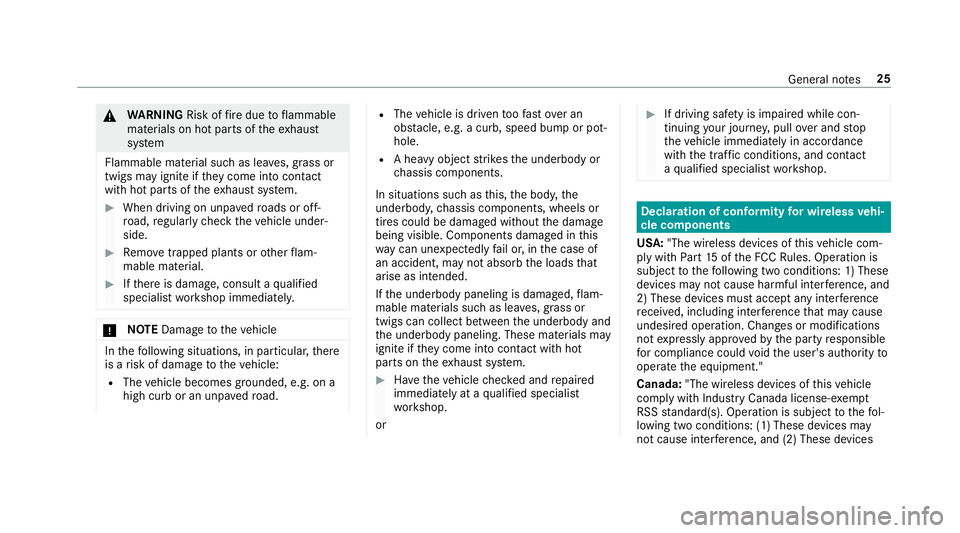
&WARNING Risk offire due toflammable
materials on hot parts of theex haust
sy stem
Flammable material such as lea ves, grass or
twigs may ignite if they come into contact
wi th hot parts of theex haust sy stem.
#When driving on unpa vedro ads or off-
ro ad, regular lych eck theve hicle underŌĆÉ
side.
#Re mo vetrapped plants or other flamŌĆÉ
mable material.
#If th ere is damage, consult a qualified
specialist workshop immediately.
* NO
TEDama getotheve hicle
In thefo llowing situations, in particular, there
is a risk of damage totheve hicle:
RThe vehicle becomes grounded, e.g. on a
high curb or an unpa vedro ad.
RThe vehicle is driven toofast over an
obs tacle, e.g. a curb, speed bump or potŌĆÉ
hole.
RA heavy object strike sth e underbody or
ch assis components.
In situations such as this, the body, the
underbody, chassis components, wheels or
tires could be damaged without the damage
being visible. Components damaged in this
wa ycan unexpec tedly fail or, in the case of
an accident, may not absorb the loads that
arise as intended.
If th e underbody paneling is damaged, flamŌĆÉ
mable materials such as lea ves, grass or
twigs can collect between the underbody and
th e underbody paneling. These materials may
ignite if they come into contact wi thhot
parts on theex haust sy stem.
#Ha ve theve hicle checked and repaired
immediately at a qualified specialist
wo rkshop.
or
#If driving saf etyis impaired while conŌĆÉ
tinuing your journe y,pull over and stop
th eve hicle immediately in accordance
with the traf fic conditions, and contact
a qu alified specialist workshop.
Declaration of conformity for wi reless vehiŌĆÉ
cle co mponents
USA: "The wireless devices of this vehicle comŌĆÉ
ply with Part15 ofthe FCC Rules. Operation is
subject tothefo llowing two conditions: 1) These
devices may not cause harmful inter fere nce, and
2) These devices must accept any interfere nce
re ceive d, including inter fere nce that may cause
undesired operation. Change s or modifications
not expressly appr ovedby the party responsible
fo r compliance could void the user's authority to
operate the equipment."
Canada: "The wireless devices of this vehicle
comply with Industry Canada license-e xemp t
RSS standard(s). Operation is subject tothefo lŌĆÉ
lowing two conditions: (1) These devices may
not cause inter fere nce, and (2) These devices
General no tes 25
Page 57 of 502

#Route TopTe ther belt 4under head
re stra int 1 between the two head restra int
bars.
#Hook TopTe ther hook 5ofTopTe ther belt
4 without twisting into TopTe ther anchorŌĆÉ
age 3.
#Tension TopTe ther belt 4. Alw ays comply
with thech ild restra int sy stem manufacturŌĆÉ
er's ins tallation instructions when doing so.
#Fo ld down co ver2 ofTopTe ther anchorage
3.
#If necessar y,slide head restra int 1 downŌĆÉ
wa rds (ŌåÆpage 86). Make sure that youdo
not inter fere with the cor rect routing of Top
Te ther belt 4.
Childrestra int sy stems on the front
passenger seat
Note s onchild restra int sy stems on the front
passenger seat
Ac cident statistics show that children secured in
th ere ar seats are safer than children secured in
th e front seats. Forth is reason, Mercedes-Benz
stro ngly advises that you ins tall a child restra int
sy stem on a rear seat.
If it is absolutely necessary toins tall a child
re stra int sy stem on the front passenger seat,
alw ays obser vethe information on the automatic
front passenger front airbag shutoff
(
ŌåÆpage 43).
By doing this, you can avoidrisks caused by:
RAch ild restra int sy stem that is not de tected
by the automatic front passenger front airbag
shutoff.
RThe unintentionally deactivated front
passenger airbag.
RIncor rect positioning of thech ild restra int
sy stem.
Note s onforw ard-facing and rear wa rd-facing
ch ild restra int sy stems on the front
passenger seat
When using a rear wa rd-facing child restra int sysŌĆÉ
te m on the front passenger seat, the front
passenger front airbag must alw ays be deactivaŌĆÉ
te d. This is only the case if thePA SSENGER AIR
BA G OFF indicator lamp is lit continuously
(
ŌåÆpage 45).
When using thech ild restra int sy stem on the
front passenger seat, it is essential toobser ve
th efo llo wing:
RMo
vethe front-passen ger seat as far back as
possible and also into the highest position.
RSet the seat backrest toan almost vertical
position.
RRe tract the seat cushion length as far as posŌĆÉ
sible.
RThe entire base of thech ild restra int sy stem
must alw aysre st on the seat cushion of the
front-passenger seat.
Occupant saf ety 55
Page 153 of 502

Overview of driving systems and driving
saf ety sy stems
In this section, youwill find information about
th efo llowing driving sy stems and driving saf ety
sy stems:
R360┬░ Camera (ŌåÆpage 187)
RABS ( Anti-lo ckBra king Sys tem)
(ŌåÆpage 151)
RAc tive Dis tance Assist DISTRONIC
(ŌåÆpa ge 162)
RAIR BODY CONTROL (ŌåÆpage 174)
RAc tive Brake Assi st(ŌåÆpage 155)
RAc tive Lane Keeping Assist (ŌåÆpage 205)
RATTENTION ASSIST (ŌåÆpage 195)
RBA S (Bra keAssist System) (ŌåÆpage 151)
REBD ( Electronic Brakefo rc eDistribution)
(ŌåÆpage 155)
RESP®(E lectronic Sta bility Program)
(ŌåÆpage 152)
RHill Start Assist (ŌåÆpage 173)
RHOLD function (ŌåÆpage 173)
RST EER CONTROL (ŌåÆpage 155)
RAc tive Steering Assist (ŌåÆpage 167)
RAc tive Parking Assist (ŌåÆpage 190)
RParking Assist PARKTRONI C (ŌåÆpage18 2)
RRe ar view camera (ŌåÆpage 185)
(ŌåÆpag e18 7)
RCruise control (ŌåÆpage 159) (ŌåÆpag e16 0)
RBlind Spot Assist andActive Blind Spot Assi st
(ŌåÆpage 202) (ŌåÆpage 203) (ŌåÆpage 202)
RTr af fic Sign Assist (ŌåÆpage197)
Fu nctions of ABS (Anti-lock Brake Sy stem)
ABS regulates the brake pressure in critical drivŌĆÉ
ing situations:
RDuring braking, e.g. at maximum full-s top
braking or insuf ficient traction of the tires,
th e wheels are pr evented from blocking.
RVehicle steerability while braking is ensured.
If ABS inter venes when braking, youwill feel a
pulsing in the brake pedal. The pulsating brake
pedal can be an indication of hazardous road conditions and can ser
veas a reminder totake
ex tra care while driving.
Sy stem limitations
RABS is active from speeds of appr ox. 5 mph
(8 km/h).
RABS may be impaired or may not function if a
malfunction has occur red and theye lŌĆÉ
low ! ABSwarning lamp lights up continŌĆÉ
uously in the instrument clus ter af terth e
engine is star ted.
Fu nction of BAS (Brake Assist Sy stem)
&
WARNING Risk of an accident caused by
a malfunction in BAS (Brake Assist SysŌĆÉ
te m)
If BA S is malfunctioning, the braking dis tance
in an eme rgency braking situation is
increased.
#Depress the brake pedal with full forc e
in emer gency braking situations. ABS
pr eve nts the wheels from locking.
Driving and parking 15
1
Page 154 of 502
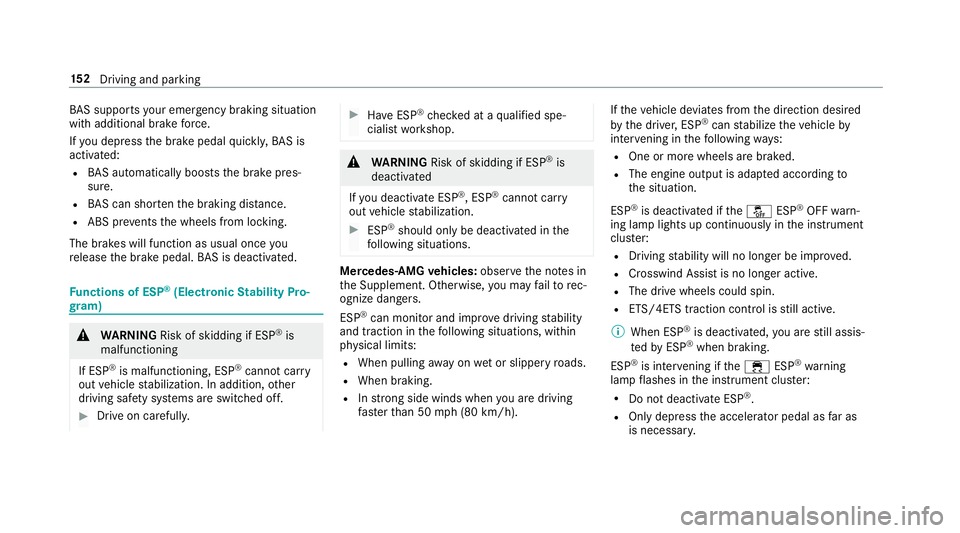
BAS suppo rts yo ur eme rgency braking situation
with additional brake forc e.
If yo udepr essthe brake pedal quickl y,BA S is
acti vated:
RBA S au tomatical lyboosts the brake presŌĆÉ
sure.
RBA S can short enthe braking dis tance.
RABS pr events the wheels from locking.
The brakes will function as usual once you
re lease the brake pedal. BAS is deactivated.
Functions of ESP┬«(Electronic Stability ProŌĆÉ
gr am)
&
WARNING Risk of skidding if ESP®is
malfunctioning
If ESP
®is malfunctioning, ESP®cannot car ry
out vehicle stabilization. In addition, other
driving saf etysy stems are switched off.
#Drive on carefull y.
#Have ESP┬«checked at a qualified speŌĆÉ
cialist workshop.
&
WARNING Risk of skidding if ESP®is
deactivated
If yo u deactivate ESP
®, ESP®cannot car ry
out vehicle stabilization.
#ESP®should only be deactivated in the
fo llowing situations.
MercedesŌĆæAMG vehicles: observeth e no tes in
th e Supplement. Otherwise, you may failto recŌĆÉ
ognize dangers.
ESP
®can monito r and improvedriving stability
and traction in thefo llowing situations, within
ph ysical limits:
RWhen pulling away on wet or slippe ryroads.
RWhen braking.
RIn stro ng side winds when you are driving
fast erthan 50 mph (80 km/h). If
th eve hicle deviates from the direction desired
by the driver, ESP
®can stabilize theve hicle by
inter vening in thefo llowing ways:
ROne or more wheels are braked.
RThe engine output is adap ted according to
th e situation.
ESP
┬«is deactivated if the├ź ESP┬«OFFwarnŌĆÉ
ing lamp lights up continuously in the instrument
clus ter:
RDriving stability will no longe r be improved.
RCrosswind Assist is no longer active.
RThe drive wheels could spin.
RETS/4ETS traction control is still active.
% When ESP
┬«is deactivated, you are still assisŌĆÉ
te dby ESP®when braking.
ESP
┬«is inter vening if the├Ę ESP┬«warning
lamp flashes in the instrument clus ter:
RDo not deacti vate ESP®.
ROnly depress the accelera tor pedal as far as
is necessar y.
152
Driving and pa rking
Page 209 of 502

#Always make sure that there is suf fiŌĆÉ
cient dist ancetothe side forot her trafŌĆÉ
fi c or obs tacles.
&
WARNING Risk of accident despite Lane
Ke eping Assist
Lane Keeping Assist cannot always clearly
de tect lane markings.
In such cases, Lane Keeping Assist can:
Rgive an unnecessary warning
Rnot give a warning
#Alw ays pay particular attention tothe
traf fic situation and keep within the
lane, especially if Active Lane Keeping
Assist alerts you.
Re quirements
The driving speed is at least 40 mph (60 km/h).
#Press button 2.
If indicator lamp 1lights up, Lane Keeping
Assist is activated. When lane markings are
de tected, the lines in the assis tance graphic
are shown in white.
Sensitivity of Active Lane Keeping Assist
Wi th th est andard or adaptive setting, you can
influence when thewa rning vibration of Lane
Ke eping Assist take s place. In bo
th thest andard and adaptive settings, no
wa rning vibration occurs in thefo llowing situaŌĆÉ
tions:
RYo u ha veswitched on the turn signal indicaŌĆÉ
to r.
RA driving safe ty system inter venes, such as
ABS, BAS or ESP®.
In the adaptive setting, there will also be no
wa rning vibration in thefo llowing situations:
RThe vehicle is accelerated or braked considŌĆÉ
erably.
RYo usteer actively, e.g. swer vetoavo id an
obs tacle or change lane quickl y.
RYou cut the corner on a sharp bend.
Setting the sensitivity of Active Lane KeepŌĆÉ
ing Assist
Multimedia sy stem:
,Vehicle.k Assistance.Act.
Lane Keep. Assist
#Select a setting.
Driving and parking 207
Page 350 of 502
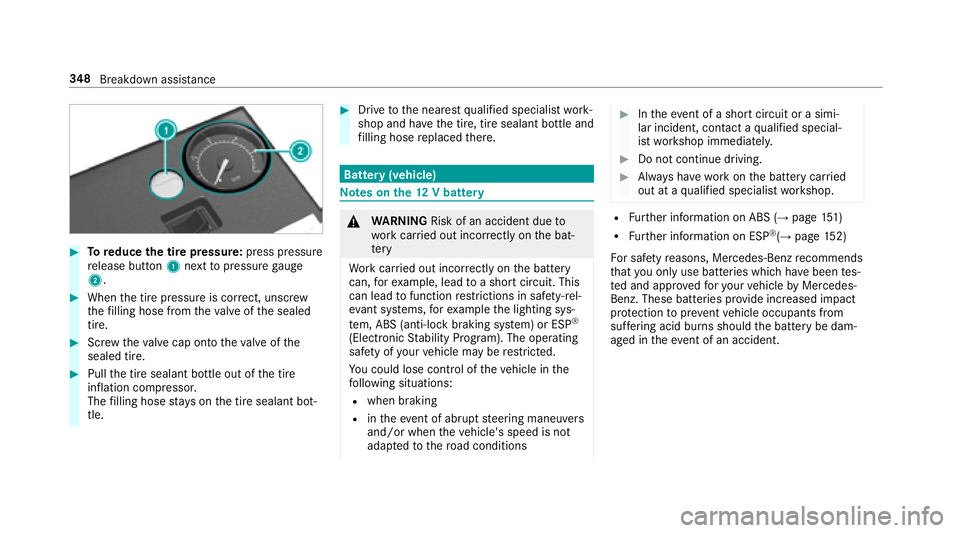
#Toreduce the tire pressure: press pressure
re lease button 1next topressure gauge
2.
#When the tire pressure is cor rect, unscr ew
th efilling hose from theva lve of the sealed
tire.
#Scr ew theva lve cap onto theva lve of the
sealed tire.
#Pull the tire sealant bottle out of the tire
inflation compressor.
The filling hose stay s on the tire sealant botŌĆÉ
tle.
#Drive tothe nearest qualified specialist workŌĆÉ
shop and ha vethe tire, tire sealant bottle and
fi lling hose replaced there.
Bat tery (vehicle)
Note s onthe12 V battery
&
WARNING Risk of an accident due to
wo rkcar ried out incor rectly on the batŌĆÉ
te ry
Wo rkcar ried out incor rectly on the battery
can, forex ample, lead toa short circuit. This
can lead tofunction restrictions in saf ety-re lŌĆÉ
eva nt sy stems, forex ample the lighting sysŌĆÉ
te m, ABS (anti-lock braking system) or ESP
®
(Elect ronic Stability Prog ram). The operating
saf etyof your vehicle may be restricted.
Yo u could lose cont rol of theve hicle in the
fo llowing situations:
Rwhen braking
Rin theeve nt of ab rupt steering maneuvers
and/or when theve hicle's speed is not
adap tedto thero ad conditions
#In theeve nt of a short circuit or a simiŌĆÉ
lar incident, contact a qualified specialŌĆÉ
ist workshop immediately.
#Do not continue driving.
#Alw ays ha vewo rkon the battery car ried
out at a qualified specialist workshop.
RFu rther information on ABS (ŌåÆpage 151)
RFu rther information on ESP┬«(ŌåÆpage 152)
Fo r saf etyre asons, Mercedes-Benz recommends
th at you only use batte ries which ha vebeen tesŌĆÉ
te d and appr oved foryo ur vehicle byMercedes-
Benz. These batteries pr ovide inc reased impact
pr otection toprev ent vehicle occupants from
suf fering acid bu rns should the battery be damŌĆÉ
aged in theev ent of an accident.
34 8
Breakdown assis tance
Page 384 of 502
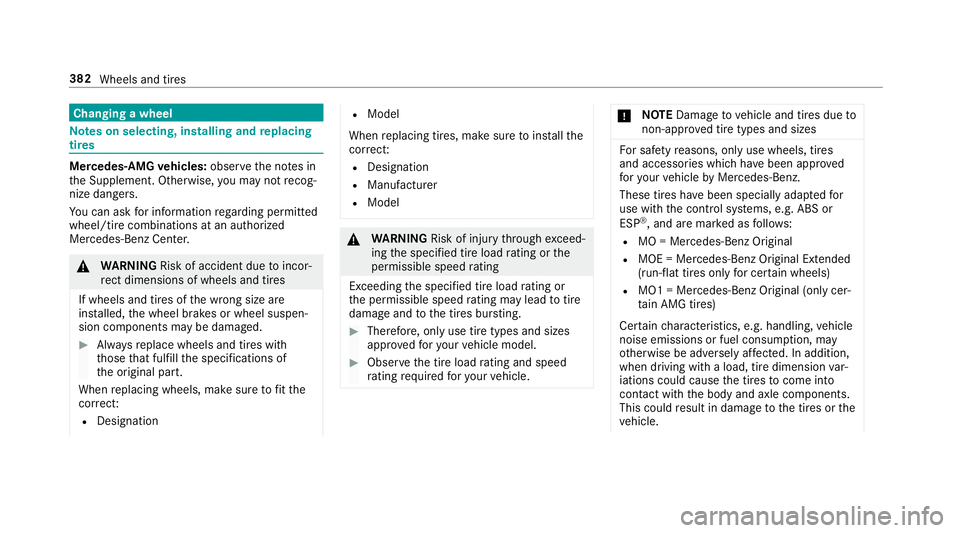
Changing a wheel
Notes on selecting, installing and replacing
tires
Mercedes -AMG vehicles: observeth e no tes in
th e Supplement. Otherwise, you may not recogŌĆÉ
nize dangers.
Yo u can ask for information rega rding permitte d
wheel/tire combinations at an authorized
Mercedes-Benz Center.
& WARNING Risk of accident due toincorŌĆÉ
re ct dimensions of wheels and tires
If wheels and tires of the wrong size are
ins talled, the wheel brakes or wheel suspenŌĆÉ
sion components may be damaged.
#Alw aysre place wheels and tires with
th ose that fulfill the specifications of
th e original part.
When replacing wheels, make sure tofit th e
cor rect:
RDesignation
RModel
When replacing tires, make sure toins tallth e
cor rect:
RDesignation
RManufactu rer
RModel
&
WARNING Risk of injury thro ugh exceedŌĆÉ
ing the specified tire load rating or the
permissible speed rating
Exceeding the specified tire load rating or
th e permissible speed rating may lead totire
damage andtothe tires bur sting.
#Therefore, only use tire types and sizes
appr ovedfo ryo ur vehicle model.
#Obser vethe tire load rating and speed
ra ting requ ired foryo ur vehicle.
* NO
TEDama getovehicle and tires due to
non-app rove d tire types and sizes
Fo r saf etyre asons, only use wheels, tires
and accessories which havebeen appr oved
fo ryo ur vehicle byMercedes-Benz.
These tires ha vebeen specially adap tedfo r
use with the control sy stems, e.g. ABS or
ESP
®, and are mar ked as follo ws :
RMO = Mercedes-Benz Original
RMOE = Mercedes-Benz Original Extended
(run-flat tires only for cer tain wheels)
RMO1 = Mercedes-Benz Original (only cerŌĆÉ
tain AMG tires)
Cer tain characteristics, e.g. handling, vehicle
noise emissions or fuel consum ption, may
ot herwise be adversely af fected. In addition,
when driving wi tha load, tire dimension varŌĆÉ
iations could cause the tires tocome into
contact wi th the body and axle components.
This could result in damage tothe tires or the
ve hicle.
382
Wheels and tires
Page 401 of 502

#Do not alterth e engine oil or oil filter in
order toachie velonger change inter vals
th an prescri bed.
#Do not use additives.
#Have the engine oil changed af terth e
prescribed inter vals.
Mercedes-Benz recommends that you ha vethe
oil change car ried out at a qualified specialist
wo rkshop.
Fu rther information on engine oils and oil filters:
Rin the Mercedes-Benz Specifications for
Operating Fluids at http://be vo.mercedes-
benz.com (byen tering the designation)
Rin the Mercedes-Benz Specifications for
Operating Fluids in the Mercedes-Benz BeVo
app (by entering the designation)
Rat a qualified specialist workshop Quality and capacity of engine oil
MB-F
reigabe or MB-Appr oval
Model MB-Freigabe or MB-
Appr oval
S 560 4MATIC 229.52, 229.61
Thefollowing values referto an oil change,
including the oil filter.
Capacity
Model Capacity
S 560 4MATIC 9.5 US qt (9.0 l)
Notes on brake fluid
Obser vethe no tes on operating fluids
(ŌåÆpage 396).
& WARNING Risk of an accident due to
va por poc kets form ing in the brake sysŌĆÉ
te m
The brake fluid constantly absorbs moisture
from the air. This lo wersthe boiling point of
th e brake fluid. Ifth e boiling point is too lo w,
va por poc kets may form inthe brake sy stem
when the brakes are applied hard.
This causes the braking ef fect to be
impaired.
#Ha ve the brake fluid rene we d at the
specified inter vals.
Ha ve the brake fluid regularly changed at a qualiŌĆÉ
fi ed specialist workshop.
Only use brake fluid appr ovedby Mercedes-Benz
according toMB-F reigabe or MB-Appr oval 33 1.0.
Fu rther information on brake fluid:
Rin the Mercedes-Benz Specifications for
Operating Fluids at http://be vo.mercedes-
benz.com
Rat a qualified specialist workshop
Te ch nical da ta399
Page 407 of 502
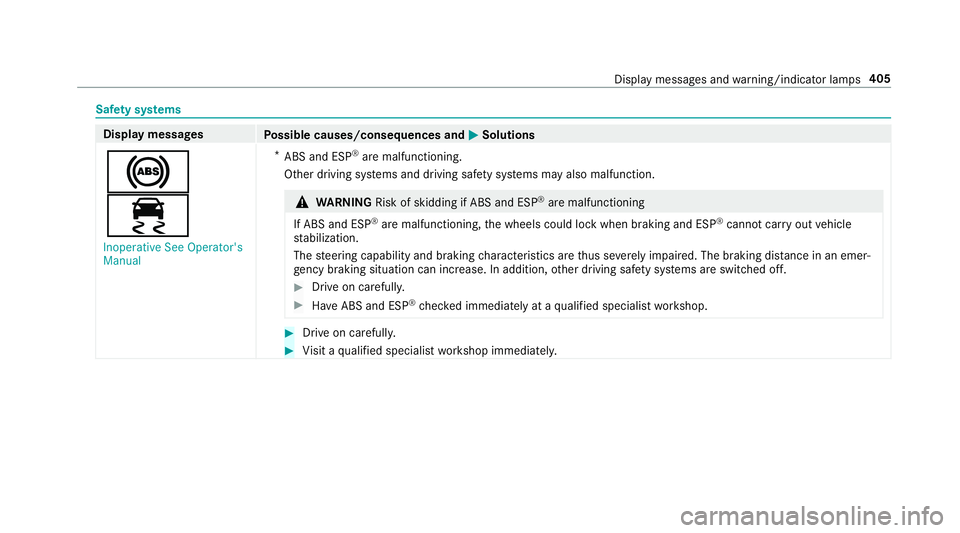
Safety sy stems
Display messages
Possible causes/consequences and MSolutions
!
├Ę
Inoperative See Operator's
Manual*
ABS and ESP
®are malfunctioning.
Other driving sy stems and driving saf etysy stems may also malfunction.
&
WARNING Risk of skidding if ABS and ESP®are malfunctioning
If ABS and ESP
®are malfunctioning, the wheels could lock when braking and ESP®cannot carryout vehicle
st abilization.
The steering capability and braking characteristics are thus se verely impaired .Th ebr aking dis tance in an emerŌĆÉ
ge ncy braking situation can increase. In addition, other driving saf etysy stems are switched off.
#Drive on carefull y.
#Have ABS and ESP®checked immediately at a qualified specialist workshop.
#Drive on carefully.
#Visit a qualified specialist workshop immediatel y.
Displaymessage s andwarning/indicator lamps 405